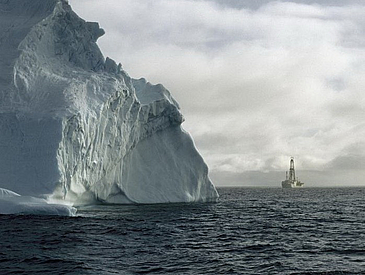The origin of the marine ecosystem in the waters surrounding Antarctica is closely intertwined with the advance of the ice cover which took place on the sixth continent some 33.5 million years ago. The current issue of the scientific journal ‘Science’ contains a report on this climate change produced by an international research team. Over the course of millions of years, the marine ecosystem comprising algae, crustaceans and other tiny organisms had a major impact on the evolutionary development of larger organisms like whales and penguins. Researchers from MARUM – the Center for Marine Environmental Sciences at the University of Bremen – had part in the publication.
Dramatic turning point in the history of Antarctica
In early 2010, an expedition belonging to the Integrated Ocean Drilling Program on board the drilling vessel “JOIDES Resolution” took the first sample of a long sediment core off the coast of Wilkes Land in Antarctica, some 3,500 kilometers south of Australia. The marine sediments they investigated bear evidence to the climatic and environmental history of the region over the past 53 million years. Previous investigation of sediment cores had already revealed that 53 million years ago the sixth continent was covered with sub-tropical vegetation. The study now published in Science records a dramatic turning point in the history of Antarctica which had far-reaching consequences for the marine ecosystem: Over the course of millions of years, the subtropical ‘greenhouse’ became a veritable icebox; Glaciers were formed. These gradually merged and 33.5 million years ago resulted in the glaciation of the entire continent.
Researchers examined single-cell dinoflagellata
In their efforts to reconstruct the environmental history of the coastal waters off Wilkes Land the team of researchers paid special attention to the single-cell dinoflagellata whose remains are embedded in the core samples they recovered. These minute organisms are also known as dinoflagellata. Because Antarctica was still subtropical and free of ice, the surrounding marine environment was home to large numbers of warmth-loving dinoflagellata. Then the climate gradually cooled down; the continent was covered with ice and the surrounding waters also iced over, with the consequence that the diversity of species rapidly declined. The warmth-loving dinoflagellata were replaced by the rather few species that are still to be found in the Antarctic ecosystem today.
“From the core samples we took we can clearly observe this abrupt change that took place in the Antarctic marine ecosystem 33.5 million years ago”, says co-author Ursula Röhl from MARUM – the Center for Marine Environmental Sciences at the University of Bremen. “We use high-resolution methods to examine the recovered drill cores in our Bremen laboratory, and our investigation showed that the occurrence of dinoflagellata fluctuated with the weathering conditions.” In the period before the Antarctic froze over the climate was dominated by chemical weathering processes. Substances like carbon dioxide leached the rocky terrain. This changed with the arrival of a cooler climate and the encroachment of glaciations. Physical weathering conditions took over, characterized by freeze-thaw weathering and frost shattering.
“Today the Antarctic waters play a significant role in the marine food web”, explains Erstautor Sander Houben from the University of Utrecht. “Only when the sea ice melts during the southern summer is it now possible for the giant algae blooms to develop that provide the nutrient source for both smaller dinoflagellata as well as larger organisms like whales and penguins.”
The IODP expedition team therefore believes that 33.5 million years ago the whales and penguins must have changed their nutritional habits, the reason being that sea ice shortens and intensifies the life cycle of algae. “We think it is therefore no coincidence that the evolution of whales and penguins coincided with the encroachment of the Antarctic ice”, says Sander Houben. The new science study is seen to provide evidence that major climate change goes hand in hand with rapid biological developments.
Science Study: A.J.P. Houben, P.K. Bijl, J. Pross, S.M. Bohaty, S. Passchier, C.E. Stickley, U. R?hl, S. Sugisaki, L. Tauxe, T. van de Flierdt, M. Olney, F. Sangiorgi, A. Sluijs, C. Escutia, H. Brinkhuis and the IODP expedition 318 Scientists: Reorganization of Southern Ocean Plankton Ecosystem at the Onset of Antarctic Glaciation, 19 April 2013 in Science
You can vie videos of the expedition here.
If you wish to obtain further information, please contact:
Universität Bremen
MARUM – Zentrum für Marine Umweltwissenschaften
Albert Gerdes
Phone: +49 421 218+65540
email: agerdesprotect me ?!marumprotect me ?!.de


